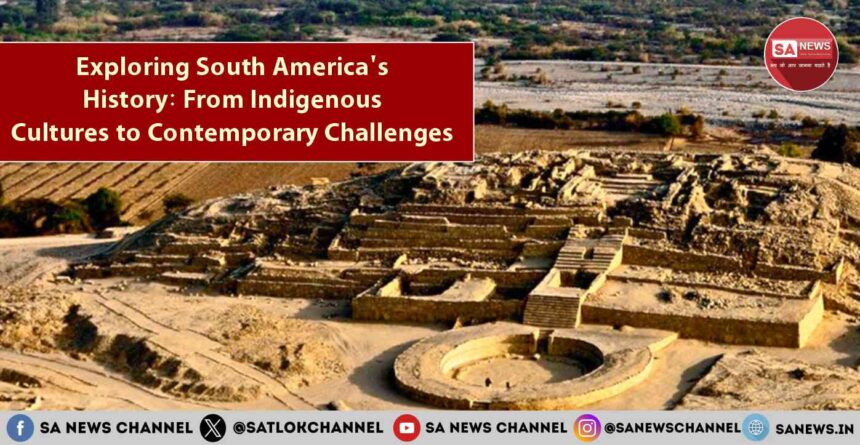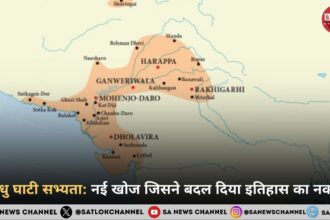South America, the fourth largest continent in the world, has a rich and varied history shaped by indigenous civilizations, European colonization, and modern development. This article explores South America’s history, from its prehistoric roots to contemporary times, highlighting pivotal events and key cultural transformations.
- Pre-Columbian Civilizations in South America
- European Colonization and Conquest
- The Fight for Independence
- Post-Independence Challenges
- The Rise of Modern South America
- Cultural Contributions of South America
- Challenges and Opportunities in the 21st Century
- South America is culturally rich country
- Spiritual Perspective: Teachings of Sant Rampal Ji Maharaj
- FAQs about History of South America
- 1. What are the most important ancient civilizations in South America?
- 2. When did South American countries gain independence?
- 3. What impact did European colonization have on South America?
- 4. How did South America transition to democracy?
- 5. What are some key cultural contributions from South America?
- Connect With Us on the Following Social Media Platforms
Pre-Columbian Civilizations in South America
South America was home to several advanced pre-Columbian civilizations, with evidence of human habitation dating back over 15,000 years. These societies thrived long before European contact, leaving behind a legacy of remarkable architectural, agricultural, and cultural achievements.
1. The Norte Chico Civilization
Located in modern-day Peru, the Norte Chico civilization (3000–1800 BCE) is among the world’s oldest known civilizations. It developed impressive urban centers and a unique system of communication based on quipus, or knotted cords.
2. The Tiwanaku and Wari Cultures
Tiwanaku (c. 300–1000 CE): Situated near Lake Titicaca, this culture is renowned for its monumental stone constructions and advanced irrigation techniques.
Wari (c. 600–1000 CE): Known for establishing one of the earliest empires in the Andes, the Wari influenced later civilizations, including the Inca.
3. The Inca Empire
The Inca Empire (1438–1533 CE) was the largest empire in pre-Columbian America, stretching across modern-day Peru, Ecuador, Bolivia, Chile, Argentina, and Colombia. The Incas built a sophisticated road system, agricultural terraces, and iconic sites like Machu Picchu. Their society was highly organized, with a central government, state-controlled economy, and a deep spiritual connection to nature.
European Colonization and Conquest
The arrival of Europeans in the 15th century marked a profound shift in South America’s history. The continent’s wealth, particularly in gold and silver, attracted explorers and conquerors.
1. Christopher Columbus and Early Exploration
Although Columbus did not reach South America, his voyages paved the way for further exploration. In 1494, the Treaty of Tordesillas divided the New World between Spain and Portugal, with much of South America falling under Spanish control.
2. Spanish Conquest
The Spanish conquest began with Francisco Pizarro’s defeat of the Inca Empire in 1533. Spain established vast colonies, exploiting the region’s resources and imposing Christianity and European cultural norms on indigenous populations.
3. Portuguese Colonization
Brazil was colonized by Portugal following the Treaty of Tordesillas. Portuguese settlers established sugar plantations and later discovered gold and diamonds, transforming Brazil into an economic powerhouse.
4. Impact on Indigenous Peoples
European diseases like smallpox decimated indigenous populations, leading to significant cultural and demographic shifts. Survivors were often forced into labor systems such as the encomienda.
■ Also Read: The American Civil War: Reshaped America’s Future
The Fight for Independence
By the late 18th century, South America witnessed growing discontent with colonial rule, inspired by the American and French revolutions. The continent’s independence movements were led by visionary leaders who sought to end European domination.
1. Key Independence Leaders
Simón Bolívar: Known as “The Liberator,” Bolívar played a crucial role in freeing Venezuela, Colombia, Ecuador, Peru, and Bolivia from Spanish rule.
José de San Martín: A revolutionary leader from Argentina, San Martín liberated Argentina, Chile, and parts of Peru.
2. Major Wars and Events
The Argentine War of Independence (1810–1818): Marked the beginning of South America’s liberation from Spain.
The Battle of Ayacucho (1824): This decisive battle secured South America’s independence from Spain.
Post-Independence Challenges
While independence brought freedom from European rule, it also ushered in a period of political instability and economic challenges.
1. Fragmentation and Civil Wars
Newly independent states struggled with internal divisions, leading to regional conflicts and civil wars. For instance, Gran Colombia, a union of several South American countries, dissolved in 1831.
2. Economic Dependency
Despite political independence, many South American nations remained economically dependent on European and North American powers, relying heavily on exports like coffee, sugar, and rubber.
The Rise of Modern South America
South America’s modern history is characterized by social reforms, industrialization, and political shifts, shaping its current identity.
1. 20th-Century Revolutions and Reforms
The Mexican Revolution (1910–1920): Inspired land reforms across Latin America.
Socialist Movements: The Cuban Revolution (1959) influenced leftist movements in South America, including in Chile, Argentina, and Venezuela.
2. Military Dictatorships
The mid-20th century saw the rise of military regimes in countries like Argentina, Brazil, and Chile. These governments often suppressed political dissent and were supported by foreign powers during the Cold War.
3. Return to Democracy
By the 1980s and 1990s, many South American nations transitioned to democratic governments. This period also saw economic liberalization and regional cooperation through organizations like MERCOSUR.
Cultural Contributions of South America
South America’s history is not only political and economic but also deeply cultural. The continent has contributed immensely to global art, literature, and music.
1. Literature
Gabriel García Márquez (Colombia): Known for his masterpiece One Hundred Years of Solitude.
Pablo Neruda (Chile): A Nobel Prize-winning poet celebrated for his passionate and political works.
2. Art and Architecture
South America is home to unique art forms, from ancient Inca stonework to vibrant modern murals. Notable sites include the Christ the Redeemer statue in Brazil and the Moai statues on Easter Island.
3. Music and Dance
South America is the birthplace of iconic musical genres like samba, tango, and bossa nova. Traditional dances like capoeira and cumbia reflect the continent’s rich cultural diversity.
Challenges and Opportunities in the 21st Century
South America faces significant challenges, including economic inequality, deforestation, and political corruption. However, the continent is also rich in opportunities.
1. Economic Growth
Countries like Brazil, Chile, and Peru have become key players in global markets, particularly in agriculture, mining, and energy.
2. Environmental Conservation
South America is home to the Amazon rainforest, the “lungs of the Earth.” Efforts to combat deforestation and climate change are crucial for the region’s future.
3. Social Progress
Movements for indigenous rights, gender equality, and social justice are reshaping South America’s societal landscape.
South America is culturally rich country
The history of South America is a testament to resilience, adaptation, and cultural richness. From ancient civilizations to modern democracies, the continent has evolved through trials and triumphs. South America, the continent, has a rich and diverse history. It was once home to ancient civilizations like the Incas, known for their architectural and agricultural advancements. After the arrival of Europeans in the 15th century, South America underwent significant changes, including colonization, the exploitation of natural resources, and the suppression of indigenous cultures.
The fight for independence in the 19th century led by leaders like Simón Bolívar and José de San Martín marked a new era for the continent. Today, South America thrives with its rich cultural heritage, diverse communities, and continuous spiritual and economic growth, influenced by both its indigenous roots and global interactions.
As South America moves forward, its vibrant heritage and diverse populations continue to shape its path on the global stage.
By understanding South America’s past, we gain insight into the forces that have shaped its present and the opportunities that lie ahead for its future.
Spiritual Perspective: Teachings of Sant Rampal Ji Maharaj
Universally renowned Spiritual Leader Sant Rampal Ji Maharaj Ji’s spiritual knowledge resonatese deeply with the people of South America, a continent rich in diverse cultures and spiritual traditions. His emphasis on devotion to the Supreme God and the importance of true worship aligns with the deep spiritual roots that many South American communities have. The continent, historically shaped by both indigenous beliefs and Christian influences, can find a path of unity and spiritual awakening in the teachings of Sant Rampal Ji Maharaj Ji.
In today’s South America, where people face challenges such as economic inequality, political instability, and environmental concerns, Sant Rampal Ji’s message of inner peace, righteousness, and devotion offers a way for individuals to overcome these difficulties. His teachings encourage people to connect with the divine through true worship, leading to a life of contentment and fulfillment, regardless of external circumstances.
Moreover, Sant Rampal Ji Maharaj Ji’s focus on the sanctity of life, non-violence, and the pursuit of spiritual liberation can help foster a greater sense of unity and compassion among South Americans, promoting harmony across different cultures and religions. As the continent continues to evolve, His guidance offers a spiritual solution that can uplift individuals and communities, helping them rediscover their true purpose and inner peace. Follow for more spiritual teachings on Spiritual Leader Sant Rampal Ji Maharaj YouTube channel.
FAQs about History of South America
1. What are the most important ancient civilizations in South America?
Key ancient civilizations in South America include the Inca, Tiwanaku, and Wari cultures. The Inca Empire, in particular, was the largest and most advanced in the region, known for its road systems and agricultural innovations.
2. When did South American countries gain independence?
Most South American nations gained independence in the early 19th century, with notable leaders like Simón Bolívar and José de San Martín fighting to free countries from Spanish rule.
3. What impact did European colonization have on South America?
European colonization led to the exploitation of natural resources, forced labor of indigenous populations, the spread of Christianity, and major demographic shifts due to diseases brought by Europeans.
4. How did South America transition to democracy?
After decades of military dictatorships in the 20th century, many South American countries transitioned to democracy in the 1980s and 1990s, fostering political stability and social reform.
5. What are some key cultural contributions from South America?
South America is known for its rich cultural heritage, including iconic music and dance styles like samba, tango, and bossa nova, as well as influential literary figures like Gabriel García Márquez and Pablo Neruda.









